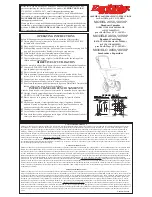
- 25 -
NEW LEADER • NL5000G5 AGCO
www.New-Leader.com
(800) 363-1771
314520-AA-A
Page Rev. A
Header
LIFTING THE SPREADER
WARNING
Use only lifting devices that meet or exceed OSHA standard 1910.184 or ASME B30.20-2006.
Never lift equipment over people. Never lift unit with anything or anybody in the body.
Loads may shift or fall if improperly supported, causing damage to unit, injury or even death.
CAUTION
Do not use lifting device to free unit from a chassis, storage stands or frozen ground, or to
lift the chassis in any way. Shock loading is prohibited and sudden accelerations should be
avoided. Lifting in such a manner could result in damage to unit or injury.
Always inspect unit lift points for signs of wear, cracking, corrosion, gouges, alterations, or distortion.
Always use a sling, spreader bar, or lifting bar that
attaches to the lifting points with a minimum of 60
degrees from horizontal. It is preferable to use an
“H” style lifting bar that keeps the attaching chains
in a near vertical orientation as shown in Figure 1.
Operators of lifting devices must be qualified and
knowledgeable in their use and application.
Position the chassis with adequate room around the
unit. Work in an environment that permits clear
communication to others nearby. Keep area clear of
persons when loads are to be lifted and suspended.
Do not allow the lifted load to come in contact with
any obstruction.
Store units on a solid surface using appropriate storage
stands when not installed.
Figure 1 - Lifting Bar
Header
Installation
SPREADER HYDRAULIC REQUIREMENTS
Hydraulics
Maximum Flow
GPM (LPM)
Maximum Pressure
PSI
Spinners & Conveyor
40 - 42 (151 - 159)
3100
MultApplier
9 - 12 (34 - 45)
1500
MultiBin
9 (34)
Recommended sequence of installation is:
1.
Mounting of spreader.
2.
Installation of chassis hydraulic hose and electrical wiring to spreader.
3.
Installation of optional parts.
4.
Filling of hydraulic reservoir and lubrication.
5.
Checking for leaks and proper functioning.
















































